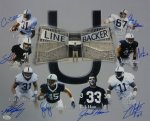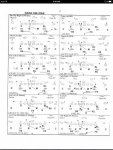There seems to be some small confusion about one of HYATT™'s previous replies regarding Harris training up younger talent - since there is no younger talent immediately available for him to train on the roster.
That's KIND OF the point, isn't it?
The Jets certainly are not going into the season with ONLY Harris at MIKE ILB, (more on MIKE ILB later), and they don't look to be wanting to invest in any ILB free agents left either - which leaves only one alternative source of acquiring one or more of them - the NFL draft.
Draft picks, the very definition of which is YOUNG PLAYERS, for Harris to school up.
Honestly, I guess I shouldn't be surprised after all these years of dealing with it - yet, I still am - about how quickly people push in the clutch to disengage their brain gear when participating in what is supposed to be INTELLIGENT football discussions.
The above corollary, I would have thought, was SO damn obvious that it should never have been required to be spelled out.
Guess again, HYATT™. :smiley-angry046:
LINEBACKERS
NFL defenses primarily use one of 2 systems - the 3-4 defense, with 4 linebackers, or the 4-3 defense with 3 linebackers.
Each has appropriated the same terms for their linebacker positions and responsibilities, though of necessity the 3-4 had to come up with one extra over the 4-3.
From left to right of the defense they are as follows;
SAM (strong side outside)
TED (strong side inside - only in 3-4 sets)
MIKE (weak side inside)
WILL (weak side outside)
Positional responsibilities change a bit, depending on which system is in play.
SAM is foremost charged with holding the strong side edge, (offensive RT, RG, & TE blocking for a runner), on running plays and preventing the TE from opening up underneath along the strong side sideline - in BOTH systems - though his pass coverage duties are slightly more accented in the 4-3 system, where there is no TED linebacker to pick up TEs and slot receivers coming across underneath.
SAM linebackers tend to be a little slower afoot and a little bigger in heft than other LBs in a 4-3, except for MIKE LBs who are often pretty big, in the 248#+ range no matter which system they play in.
SAM linebackers are also the backup pass-rushing LOLB in 3-4 defenses, with first responsibility going to the ROLB, who takes the place of the 4-3 pass-rush DE in the 3-4 system.
On pass plays BOTH the SAM and WILL LBs are expected to get to the QB, while the 3-4 DEs keep them clean by sucking up double-teams of an OT & TE/OG.
TED linebackers are exclusive to 3-4 defensive fronts. Their primary occupation is to provide tight coverages on any RB, slot receiver, or TE, who runs a shallow quick slant, shallow crossing play, or shallow inside curl/button routes.
TED linebackers are expected to absorb strong side inside runs and be the first of the 2 ILBs to attempt an inside blitz, if called, while the MIKE linebacker picks up his rear and protects the middle in case the TED misses his assignment or tackle as he heads upfield after the QB or RB behind the LoS.
TED linebackers are also charged with coverage on deeper middle of the field pass coverages on TEs and slot WRs, so nimble feet and smooth hips are in the job description of good TED linebackers. 40 speed and read & react drill numbers, (splits and 3-cone) are more important for TED than for MIKE ILBs, & TED linebackers are often the smallest LBs in a 3-4 defense, weighing as little as the mid-230# range. Big Safeties (225#+) are also employed as TED linebackers in certain 4-3 looks where there is only single-high coverage deep.
MIKE linebackers are the on-field coach of the front 7 and can dictate Safety coverages as well.
They are responsible for making sure everyone behind the DL is in place and ready to execute sudden shifts to confuse the offensive line. You'll often see very subtle hand motions, (at hip level), as the MIKE ILB waves off or brings up coverages, based on his read of the offense's set, and when calling the timing of any swing stunt blitzes the LBs have planned.
MIKE ILBs tend to be big, though not exclusively. 248#-255# is the weight range for them, as opposed to the low to middle 240#-ish range for OLBs in a 4-3 and the 255# or bigger range for OLBs in 3-4 defenses.
In certain 4-3 defenses, the MIKE ILB is actually the smaller guy, but usually only if the DTs are massive oaks growing roots and the DEs are also on the large side for 4-3 DEs, in the 265#-275# class.
In that type of 4-3 system, the MIKE or Middle Linebacker is the only guy to cover TEs and slot receivers across the middle, (with some Safety and nickle CB help), and must necessarily be fast - sideline to sideline fast - as well as have very good pass coverage skills.
MIKE linebackers tend to be the designated inside/delay run-blitzers in either system, and will use the TED ILB to clear a path for them.
WILL linebackers who are undersized, but fast, can make the switch to MIKE pretty easily but tend to not make the best run-stuffers or blitzers inside.
Last but not least we come to perhaps the most demanding linebackers spot.
WILL or ROLBs are the designated pass rushers in a 3-4 defense, against right-handed QBs.
WILL linebackers in both systems need speed, to get to the edge on the larger side of the offensive field, to cover Flanker/Split End WRs & the occasional weak side TE & out-route slot receiver in the shallow part of their routes, to get in front of RBs, (who tend to have slightly better foot speed than LBs by virtue of being smaller & lighter), on the weak side edge, and they still have pass-rush duties even in the 4-3.
3-4 "WILL" (ROLBs) ARE the pass rushers for that defensive system, yet STILL have to have all the other qualities of a 4-3 ROLB as well.
PLUS, 3-4 WILL OLBs need great agility to evade, undercut, and get around the outside of, the best blocking offensive lineman - the Left Tackle - on both run and pass plays.
WILL OLB is the premiere LB position in the NFL, regardless of system, and most of them command significantly higher salaries than other LBs, inside or out.
Long arms, height, and big wingspan, is a definite advantage for WILL LBs.
I haven't covered all the LB spots in great detail, that was just an overview - but I do hope it helps others to better understand the distinctions between the 4 LB positions.
David Harris is a MIKE ILB, incidentally.


